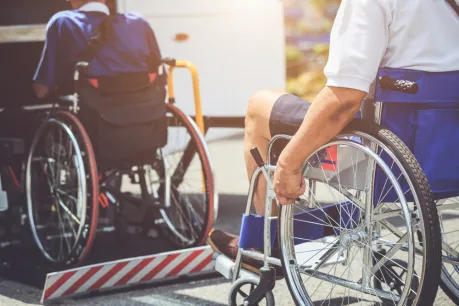Access-A-Ride Accident Lawsuits: Your Legal Rights After a Paratransit Injury

Key Takeaways
- If you’re injured while using Access Ride or another paratransit service, you may have legal rights to compensation for your injuries.
- Paratransit accidents can result from driver negligence, poor vehicle maintenance, or failure to follow safety protocols.
- Documenting the accident, seeking medical care, and preserving evidence are important steps in building a strong claim.
- If you were hurt in a paratransit injury, contact Morgan & Morgan to protect your rights and pursue the compensation you deserve.
Injured?
For many New Yorkers with disabilities or mobility limitations, Access-A-Ride is more than a transportation program; it’s a lifeline. This paratransit service, run by the MTA, helps thousands of people get to medical appointments, school, work, and essential services across the city.
But what happens when that ride turns into a serious accident?
Whether it’s a crash involving another vehicle, a wheelchair securement failure, or a dangerous fall while boarding, Access-A-Ride accidents can lead to devastating injuries, and in some cases, permanent disability or death. You may be entitled to compensation if you or someone you love has been hurt in an Access-A-Ride vehicle.
What Is Access-A-Ride?
Access-A-Ride is a shared-ride, door-to-door transportation service provided under the Americans with Disabilities Act (ADA). It’s meant to offer comparable service to public transit for people who cannot use subways or buses due to a disability.
These vehicles are typically operated by contracted drivers, not MTA employees, and are supposed to follow strict safety standards. Unfortunately, that doesn’t always happen.
Common Access-A-Ride Accident Scenarios
Accidents involving Access-A-Ride vehicles can occur in many different ways. Some of the most common include:
- Traffic collisions with cars, trucks, cyclists, or pedestrians
- Falls while entering or exiting the vehicle, especially if the driver doesn’t assist properly
- Wheelchair tip-overs or unsecured mobility devices during transport
- Sudden stops or reckless driving, leading to injuries even without a crash
- Driver negligence, such as distracted driving, speeding, or failure to follow protocols
- Poor vehicle maintenance, including malfunctioning lifts or safety straps
These incidents can result in broken bones, head trauma, spinal injuries, internal bleeding, or worse. Victims are often already vulnerable, elderly, disabled, or relying on the service for essential travel, making injuries even more serious.
Who Is Liable for an Access-A-Ride Injury?
Determining liability in Access-A-Ride accidents can be complex. In many cases, more than one party may be responsible:
- The driver if their actions or inaction directly caused the injury
- The transportation company contracted by the MTA
- The MTA, depending on the specific circumstances
- Other motorists, cyclists, or pedestrians involved in a crash
- Maintenance contractors, if the vehicle was not properly serviced
An experienced attorney can investigate who is at fault and ensure they’re held accountable.
Access-A-Ride Accidents Involving Negligence
Not all injuries happen in major crashes. Many Access-A-Ride claims involve everyday negligence, like:
- A driver failing to use the lift correctly
- Straps not securing a wheelchair properly
- Failing to lock the brakes on a mobility device
- Not offering assistance to someone who clearly needs it
- Speeding or swerving while passengers are unrestrained
These may seem like minor oversights, but when you’re dealing with someone who is elderly, recovering from surgery, or dependent on a wheelchair, small mistakes can have life-changing consequences.
What to Do If You’re Hurt in an Access-A-Ride Incident
After an injury, it’s easy to feel overwhelmed, especially when navigating a public service system. But there are steps you can take to protect yourself and your claim:
- Seek medical attention immediately: Even if you feel okay at first, internal injuries and head trauma can take time to appear.
- Report the incident: Make a report with the driver or Access-A-Ride/MTA. Be as detailed as possible.
- Take photos if you can: Capture the vehicle, the injury, your surroundings, and any visible hazards.
- Get witness information: If anyone else saw what happened, their testimony could support your case.
- Preserve your records: Save all medical documentation, transit receipts, and communications with Access-A-Ride.
- Speak with a personal injury attorney: Time limits apply when suing public transit authorities, and the legal process can be complicated.
Suing the MTA or Access-A-Ride Contractors
Filing a claim against a public entity like the MTA can differ from suing a private company. In New York, there are strict deadlines:
- A Notice of Claim must often be filed within 90 days of the incident.
- There may be limitations on damages or other procedural hurdles.
That’s why having an experienced legal team on your side is critical. At Morgan & Morgan, we understand the process and have the resources to fight for you.
What Compensation Can Cover
If your injury was caused by Access-A-Ride negligence, you may be able to recover damages for:
- Emergency room and hospital bills
- Ongoing treatment or rehabilitation
- Pain and suffering
- Loss of mobility or independence
- Lost income or future earnings
- Emotional distress
- Wrongful death (for surviving family members)
Your injury shouldn’t have happened. And you shouldn’t be left to deal with the fallout alone.
Morgan & Morgan Is Here to Help
At Morgan & Morgan, we fight For The People, including those who rely on public services like Access-A-Ride. If you were injured because of a negligent driver, unsafe vehicle, or inadequate assistance, you may have a case, and we’re ready to help.
We’ve recovered billions of dollars for our clients and have the experience to take on large transit contractors and government agencies. And with us, you pay nothing unless we win.
Contact us today for a free case evaluation.

We've got your back
Injured?
Not sure what to do next?
We'll guide you through everything you need to know.
